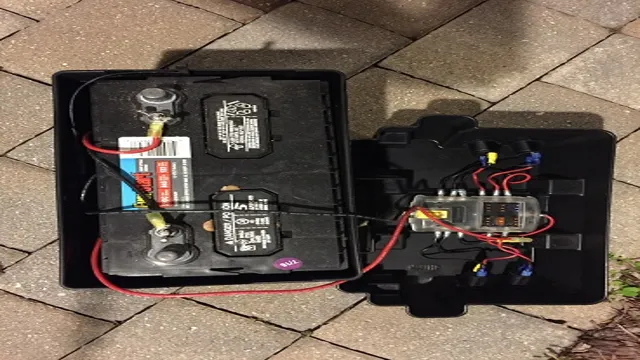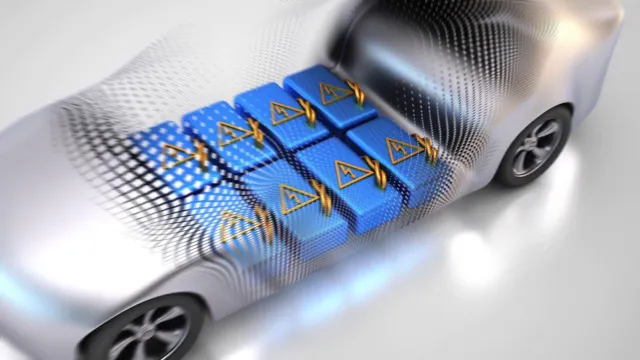Shocking Truth: Electric Car Batteries are Catching Fire! Here’s What You Need To Know
As electric cars continue to gain popularity, concerns about their safety have begun to crop up in the form of battery fires. The rising prevalence of these incidents has raised questions about the reliability of electric car batteries and the potential danger they pose. While the number of incidents is still relatively low, the potential consequences of these battery fires are significant, including property damage and serious injury.
In this blog post, we’ll take a closer look at the issue of electric car batteries catching on fire, exploring the causes, frequency, and possible solutions to this growing problem. So, buckle up and let’s dive in!
Rising Incidents
The popularity of electric cars is on the rise as more individuals are starting to prioritize environmentally friendly options. However, in recent years, there have been an increasing number of incidents of electric car batteries catching on fire. This has caused concern among car manufacturers and consumers alike, raising questions about the safety of such vehicles.
While these incidents are relatively rare, they can be incredibly dangerous and have the potential to cause significant damage. Car manufacturers are working to determine the cause of these fires and come up with preventative measures to ensure the safety of their customers. As the technology behind electric car batteries continues to improve, it is hoped that these incidents will become less frequent, making electric cars an even more attractive option for eco-conscious drivers.
Statistics of EV Battery Fires
EV battery fires are on the rise, according to recent statistics. As electric vehicles become more popular, concerns over their safety have increased. Despite the fact that EVs are generally considered safer than traditional vehicles, the risk of a battery fire is still present.
In fact, studies show that EVs have a higher risk of fire during accidents than gasoline-powered cars. One of the main causes of these fires is thermal runaway, which occurs when the batteries overheat and release energy uncontrollably. This can lead to an explosion or fire, which can be extremely dangerous.
To address these concerns, manufacturers are implementing new safety features and using better materials in the construction of EV batteries. However, it’s important for EV owners to be aware of the risks and take precautions to prevent fires from occurring. Regular maintenance and proper charging techniques can go a long way in reducing these risks and ensuring the safety of everyone on the road.

Most Vulnerable Car Models
Car theft is a rising concern these days, and some car models are particularly vulnerable. The most commonly stolen car is the Honda Civic, with its 1998 model being the most targeted. Other models, such as the Ford F-250, Toyota Camry, and Dodge Ram, are also frequently stolen.
The reason behind this is that these models have outdated security systems that are easy to bypass. Car thieves are also known to target cars that are parked in isolated and dimly lit areas or left unattended for extended periods of time. Moreover, car owners tend to take security for granted, leaving valuables and spare keys in plain sight.
To avoid being a victim of car theft, car owners should always park their cars in well-lit areas and install security systems such as alarms and immobilizers. They should also avoid leaving any valuable items inside the car and keep the spare keys in a safe place. By taking these precautions, they can greatly reduce the likelihood of their vehicles being stolen and avoid the associated inconvenience and expenses.
Causes and Precautions
Electric car batteries catching on fire is a rare occurrence but it can happen due to specific causes. One of the most common reasons for this is a manufacturing defect in the battery cells. These defects can cause overheating and result in a fire.
Another cause is damage to the battery pack after a collision or crash. Precautions can be taken to mitigate these risks, such as regular maintenance to ensure the battery is functioning correctly and using certified charging equipment. In addition, manufacturers must ensure the batteries meet strict safety standards before being installed in vehicles.
However, it’s necessary to remember that the likelihood of an electric car battery catching on fire is much lower compared to a gasoline-powered car due to the safety mechanisms installed. Let’s ensure we take proper precautions and enjoy the many benefits of electric cars.
Overheating and Thermal Runaway Explained
Overheating and Thermal Runaway can be quite detrimental to any electronic device. It can occur for a variety of reasons, such as when a device gets exposed to high temperatures, when the ventilation system is improper, or when there is a hardware malfunction. When overheating occurs, it can cause the device to shut down or sustain severe damages.
This is why it’s essential to take precautions and prevent overheating from occurring in the first place. Common precautions include keeping the device out of direct sunlight, ensuring that the ventilation system is not blocked, and avoiding using the device on soft surfaces like beds or sofas. Implementing these precautions would reduce the likelihood of any potential damage to your electronic devices due to overheating.
Preventive Measures and Safety Practices
Wildfires have become a common and devastating occurrence in many parts of the world. The main causes of wildfires include lightning, human carelessness, and natural causes like drought and extreme heat. To prevent the occurrence of wildfires, it’s important to take certain precautions like clearing dry leaves and dead vegetation from the surrounding areas, avoiding throwing cigarettes out of the car window, and keeping campfires and barbeques under control.
In addition, it’s essential to stay up-to-date with the weather forecast and follow the advice of experts to prevent wildfires from happening or to minimize their spread. Homes located in areas prone to wildfires must also be built following safety guidelines to prevent or minimize damage in the case of a wildfire. By taking these important measures, we can help prevent or minimize the devastating effects of wildfires and protect ourselves, our families, and the environment.
Battery Safety Standards and Regulations
Battery safety standards and regulations are of the utmost importance when it comes to using and handling batteries. There are several causes that can lead to battery accidents including overheating, overcharging, and short circuits. To prevent these accidents, it is essential to follow some precautions while handling batteries.
Firstly, ensure that the battery is compatible with the device and charger. Secondly, avoid overcharging or charging for prolonged periods. Thirdly, use the original charger provided by the manufacturer and avoid using damaged or faulty chargers.
Fourthly, avoid exposing the battery to extreme temperatures or fire. Last but not least, store the battery in a cool and dry place when not in use. Following these precautions will not only ensure the safety of the user but also prevent damage to the devices in use.
Therefore, it is always necessary to be cautious while handling batteries, no matter how small they may be.
EV Battery Innovations
While electric cars are more environmentally friendly than their gas-guzzling counterparts, there have been concerns about the safety of their batteries. In recent years, reports of electric car batteries catching on fire have raised red flags and slowed the adoption of these vehicles. However, innovative solutions are emerging to address this issue.
For instance, some car manufacturers are using high-tech sensors to monitor the temperature, voltage, and other factors that can contribute to battery fires. Others are experimenting with new materials and designs to create safer, more resilient batteries that can withstand a variety of situations. As these battery innovations continue to develop, we can expect to see more electric cars on the road and fewer worries about their safety.
Recent Developments in Battery Technology
Recently, there have been exciting developments in EV battery technology that have the potential to revolutionize the industry. One of the most promising innovations is the use of solid-state batteries, which offer higher energy density, faster charging times, and longer lifespans than traditional lithium-ion batteries. Additionally, some companies are exploring the use of self-healing polymer coatings and nanotechnology to improve battery performance and extend their operating life.
Overall, the EV industry is continuing to push the boundaries of what is possible with battery technology, as it seeks to create more efficient and sustainable solutions for powering our vehicles. As we move towards a cleaner and more sustainable future, these advancements will play a pivotal role in reducing our reliance on fossil fuels and transitioning to a more sustainable energy system.
Future Prospects for Safer EV Batteries
One of the biggest concerns with electric vehicles has always been the safety of their batteries. But innovative breakthroughs have led to new developments in EV batteries that are safer than ever before. For example, advances in solid-state batteries have the potential to dramatically reduce the risk of battery fires, while also increasing the energy density and driving range of EVs.
Additionally, researchers are looking into various new electrolytes for batteries that are less flammable than traditional ones, greatly reducing the risk of explosions in the event of an accident. With ongoing research and development, the future looks bright for safer EV battery technology.
Final Thoughts
Electric car batteries catching on fire has become a rising concern among car owners and manufacturers alike. While electric cars are meant to be safer for the environment and more efficient than traditional gasoline-powered vehicles, the risk of battery fires poses a new challenge. These fires can be caused by various factors, including accidents, manufacturing defects, or even improper charging.
As electric cars become more popular, it is crucial for automakers to take the necessary precautions to prevent these fires from happening. While the risk of fires can never be completely eliminated, advancements in technology and safety regulations have helped minimize the risk and make electric cars a safer alternative for the environment.
Conclusion
Evidently, when it comes to electric car batteries, fire is not just reserved for hot rods or drag races. While breakthroughs in battery technology have improved their safety and reliability, occurrences of spontaneous combustion still persist. But fear not, for clever engineers and researchers are tirelessly working to prevent any more fiery roadblocks on the way to widespread electric vehicle adoption.
In the meantime, it might be wise to have a trusty fire extinguisher on hand–just in case your green vehicle becomes a little too hot to handle.”
FAQs
What makes electric car batteries prone to catching on fire?
Electric car batteries can catch on fire due to a number of factors, including overheating, manufacturing defects, and damage to the battery cells.
Is there anything electric car owners can do to prevent battery fires?
Electric car owners can take steps to reduce the risk of battery fires, such as ensuring their vehicle is properly maintained, avoiding exposure to extreme temperatures, and following manufacturer guidelines for charging and storage.
How common are electric car battery fires?
While battery fires in electric cars are still relatively rare, there have been a number of high-profile incidents in recent years that have drawn attention to the issue.
What are automakers doing to improve battery safety?
Automakers are investing in new technologies and safety measures to improve the reliability and safety of electric car batteries. This includes developing better cooling systems, improving battery chemistry, and implementing more rigorous testing and quality control processes.






